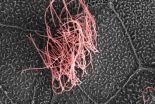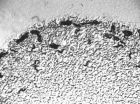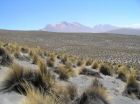LSU professor discovers world's tiniest vertebrate
Tiny frog called Paedophryne amauensis averages around 7 millimeters in size; fits in center of US dime
2012-01-13
(Press-News.org) BATON ROUGE – LSU's Chris Austin recently discovered two new species of frogs in New Guinea, one of which is now the world's tiniest known vertebrate, averaging only 7.7 millimeters in size – less than one-third of an inch. It ousts Paedocypris progenetica, an Indonesian fish averaging more than 8 millimeters, from the record. Austin, leading a team of scientists from the United States including LSU graduate student Eric Rittmeyer, made the discovery during a three-month long expedition to the island of New Guinea, the world's largest and tallest tropical island.
"It was particularly difficult to locate Paedophryne amauensis due to its diminutive size and the males' high pitched insect-like mating call," said Austin. "But it's a great find. New Guinea is a hotspot of biodiversity, and everything new we discover there adds another layer to our overall understanding of how biodiversity is generated and maintained."
Austin, curator of herpetology at LSU's Museum of Natural Science and associate professor of biological sciences, is no stranger to discovering new species, having described numerous species previously unknown to science, including frogs, lizards and parasites.
These most recent species descriptions, which will be published in PLoS ONE on Jan. 11, highlight an interesting trend among the discovery of extremely small vertebrates. The research was supported by the National Science Foundation.
"The size limit of vertebrates, or creatures with backbones, is of considerable interest to biologists because little is understood about the functional constraints that come with extreme body size, whether large or small," said Austin.
With more than 60,000 vertebrates currently known to man, the largest being the blue whale with an average size of more than 25 meters (75 feet) and the smallest previously being a small Indonesian fish averaging around 8 millimeters, there was originally some thought that extreme size in vertebrates might be associated with aquatic species, as perhaps the buoyancy offers support and facilitates the development of extremism. However, both new species of frogs Austin described are terrestrial, suggesting that living in water is not necessary for small body size.
"The ecosystems these extremely small frogs occupy are very similar, primarily inhabiting leaf litter on the floor of tropical rainforest environments," said Austin. "We now believe that these creatures aren't just biological oddities, but instead represent a previously undocumented ecological guild – they occupy a habitat niche that no other vertebrate does."
INFORMATION:
For more information about Austin's research lab, visit http://www.museum.lsu.edu/Austin/lab.html.
About the LSU Museum of Science:
The mission of the LSU Museum of Natural Science is the acquisition, preparation and study of research collections by museum faculty, staff and students to generate knowledge of regional and global biodiversity, geological history and human history and prehistory for the benefit of the people of the state, the nation and the world. The vast storehouse of scientific information held within LSUMNS collections helps researchers understand the historical and contemporary processes that have shaped the world's biological diversity. With nearly 3 million specimens and growing, the LSUMNS collections are an invaluable resource that will yield countless important discoveries for generations to come, and researchers at the museum are responsible for the discovery of nearly 60 species new to science, ranging from invertebrate fossils to reptiles, fish, birds and even mammals. For more information about the MNS, visit www.lsu.edu/museum.
END
ELSE PRESS RELEASES FROM THIS DATE:
2012-01-13
Researchers have found two new frog species in New Guinea, one of which is the new smallest known vertebrate on Earth. The results are reported in the Jan. 11 issue of the online journal PLoS ONE, and the team of researchers was led by Christopher Austin of Louisiana State University.
The new smallest vertebrate species is called Paedophryne amauensis, named after Amau Village in Papua New Guinea, where it was found. The adult body size for these frogs ranges from just 7.0 to 8.0 millimeters.
According to Dr. Austin, the discovery "is of considerable interest to biologists ...
2012-01-13
Brain cancer cells are particularly resistant to chemotherapy — toxins enter the cells, but before the toxins can kill, cancer cells quickly pump them back outside. In fact, brain cancer cells are even better than healthy cells at cleaning themselves. This means that when hit with chemotherapy, healthy cells tend to die before brain cancer cells. Especially in the brain, killing healthy cells is bad.
Researchers at the University of Colorado Cancer Center have discovered a way to turn off the pumps — only in brain cancer cells and not in their healthy neighbors. Promising ...
2012-01-13
Iron is a popular topic in health news. Doctors prescribe it for medical reasons, and it's available over the counter as a dietary supplement. And while it's known that too little iron can result in cognitive problems, it's also known that too much promotes neurodegenerative diseases.
Now, researchers at UCLA have found that in addition to causing cognitive problems, a lack of iron early in life can affect the brain's physical structure as well.
UCLA neurology professor Paul Thompson and his colleagues measured levels of transferrin, a protein that transports iron ...
2012-01-13
La Jolla ---- Scientists at the Salk Institute for Biological Studies have identified a gene that tells cells to develop multiple cilia, tiny hair-like structures that move fluids through the lungs and brain. The finding may help scientists generate new therapies that use stem cells to replace damaged tissues in the lung and other organs.
"Cells with multiple cilia play a number of important roles, including moving fluids through the respiratory tract, brain and spinal cord," says Christopher R. Kintner, a professor in Salk's Molecular Neurobiology Laboratory, who led ...
2012-01-13
PASADENA, Calif.— Scientists have long seen evidence of social behavior among many species of animals, both on the earth and in the sea. Dolphins frolic together, lions live in packs, and hornets construct nests that can house a large number of the insects. And, right under our feet, it appears that nematodes—also known as roundworms—are having their own little gatherings in the soil. Until recently, it was unknown how the worms communicate to one another when it's time to come together. Now, however, researchers from the California Institute of Technology (Caltech) and ...
2012-01-13
Sufferers of smoking related lung diseases could have their debilitating symptoms reduced following the discovery of a potential new treatment.
The discovery, by researchers at the University of Melbourne, Royal Melbourne Hospital, Australia, and the Brigham and Women's Hospital, Harvard Medical School, US, could dramatically improve treatments and slow the progression of COPD (Chronic Obstructive Pulmonary Disease) which includes the incurable condition emphysema.
COPD is a progressive disease that makes it hard to breathe and is mostly caused by excessive smoking. ...
2012-01-13
FRESNO, Calif. – Can eating grapes slow or help prevent the onset of age-related macular degeneration (AMD), a debilitating condition affecting millions of elderly people worldwide? Results from a new study published in Free Radical Biology and Medicine suggest this might be the case. The antioxidant actions of grapes are believed to be responsible for these protective effects.
The study compared the impact of an antioxidant-rich diet on vision using mice prone to developing retinal damage in old age in much the same way as humans do. Mice either received a grape-enriched ...
2012-01-13
Fungi may be unexpected allies in our efforts to keep hazardous lead under control. That's based on the unexpected discovery that fungi can transform lead into its most stable mineral form. The findings reported online on January 12 in Current Biology, a Cell Press publication, suggest that this interaction between fungi and lead may be occurring in nature anywhere the two are found together. It also suggests that the introduction or encouragement of fungi may be a useful treatment strategy for lead-polluted sites.
"Lead is usually regarded as a pretty stable substance," ...
2012-01-13
CHESTNUT HILL, MA (Jan. 12, 2012) – Researchers from Boston College have discovered a protein that plays a pivotal role in the progression of the deadly diseases toxoplasmosis and malaria and shown that its function could be genetically blocked in order to halt the progress of the parasite-borne illnesses, the team reports in the current edition of the journal Science.
The protein, identified as DOC2.1, plays a similar role in the secretion of microneme organelles that are crucial to the mobility of the parasitic protozoa Toxoplasma gondii, which causes toxoplasmosis, ...
2012-01-13
Preserving diverse plant life will be crucial to buffer the negative effects of climate change and desertification in in the world's drylands, according to a new landmark study.
The findings of the multi-author study, published today in the journal Science, are based on samples of ecosystems in every continent except Antarctica.
They confirm for the first time that the more diverse an ecosystem is, the more ecological functions it performs. It also has implications for carbon sequestration and soil health.
"This is the most extensive study of the links between function ...
LAST 30 PRESS RELEASES:
[Press-News.org] LSU professor discovers world's tiniest vertebrate
Tiny frog called Paedophryne amauensis averages around 7 millimeters in size; fits in center of US dime


